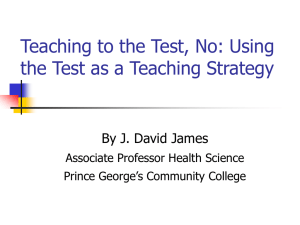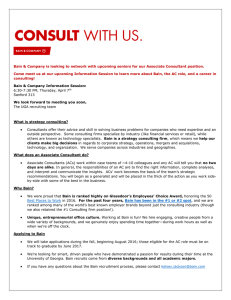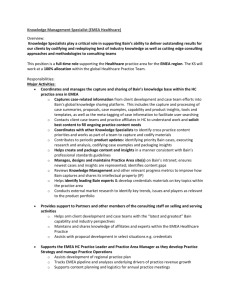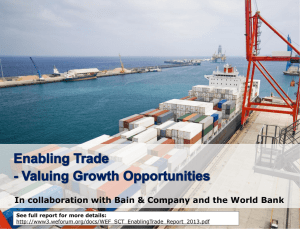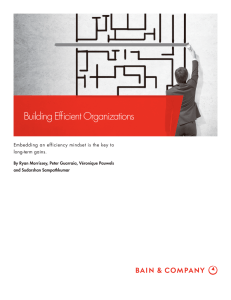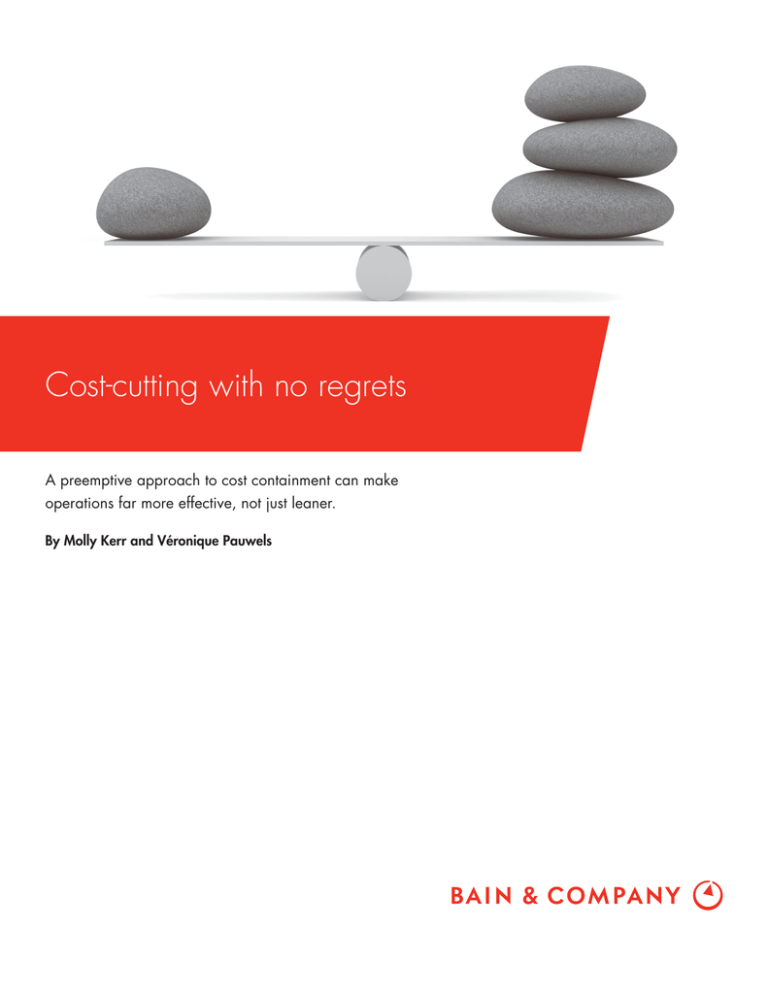
Cost-cutting with no regrets
A preemptive approach to cost containment can make
operations far more effective, not just leaner.
By Molly Kerr and Véronique Pauwels
Molly Kerr is a Boston-based partner with Bain & Company’s Performance
Improvement practice. Véronique Pauwels is an Amsterdam-based partner who
co-leads the Performance Improvement practice in Europe, the Middle East
and Africa.
Copyright © 2014 Bain & Company, Inc. All rights reserved.
Cost-cutting with no regrets
Can you get excited by cost containment?
the best initiatives, it also takes time to build the appropriate systems.
You might if you visualize your employees avidly engaged
in making operations not only efficient but also more
effective. Wringing out waste can be a liberating experience. Imagine looking back on cost-cutting efforts of
the past five years and not having a single regret.
A reasonable cadence involves assembling midlevel
teams every one to two years and challenging them to
identify potential initiatives, so a company can build an
inventory of options. The options can then be analyzed
and the best handful chosen for implementation. Similar to a capital planning process, with all the projects
arrayed and discussed annually, these midlevel teams
refresh their commitment to the cost initiatives each year.
That helps the company develop a culture of continually
scouting no-regrets moves.
Companies whose business declined or even managed to
hold flat during the recent recession have been squeezing
more productivity from existing resources. Such efforts,
especially across-the-board cuts, often are viewed as temporary and detrimental to the health of the business
once robust growth returns.
A leading medical device manufacturer runs an ongoing
process to identify and fund the best cost-reduction
ideas. Those ideas that get approved typically have
a three to one value/cost ratio, or will pay back within
a year. The process started in manufacturing and is
now used throughout all functions. As a result of
this disciplined process, the medical device firm reaps
substantial savings year after year, drawing on a rich
set of well-planned initiatives. The benefits go
b e yond cost savings, as employee teams are able
to weed out non-essential tasks and devote more time
to activities that promote innovation and improve
the customer’s experience.
But efforts to contain costs don’t have to cause gloom and
doom. In the best companies, cost programs spur major
improvements in operating effectiveness along financial,
customer, employee and other metrics. The key is to regularly and aggressively hunt for “no regrets” initiatives that
will make a company both leaner and more effective.
It may sound obvious that one should pursue cost initiatives that will make a company stronger, or at least limit
the harm done. But in practice, cost-cutting often plays
out differently. Companies tend to make cuts as a reaction
triggered by an economic downturn or a shift in the market, or because they are under pressure from investors to
deliver gains within a quarter or two. At that point, it’s too
late to take more constructive measures, which require
time to identify, plan and implement.
They carefully analyze the impact
on effectiveness
Most companies apply far more rigor to quantifying
efficiency than to increasing effectiveness. Anyone can
cut 10% of costs from a department, but to make intelligent and sustainable cuts, executives need to understand which activities are critical to the health of the
business and which are expendable because they don’t
add value. And more complicated trade-offs require
even more analytical rigor.
By contrast, companies that generate an evergreen portfolio of no-regrets cost initiatives do three things:
They launch a cost program before it’s needed
Some companies run cost-reduction initiatives proactively, to gain or maintain a lead in their industry. By beating their industry’s cost curve, they can generate higher
returns. These returns can be reinvested in strategic
priorities to further build a competitive advantage.
Companies that take this evergreen approach have found
it useful to sort potential initiatives into three categories:
But time is a precious currency. It typically takes 12 to 18
months to identify, prove and build out initiatives that
come with no regrets. And because IT often underpins
1. Clear wins. Certain initiatives will dramatically improve
both efficiency and effectiveness. Consider a global
beverage company that realized it could be smarter
1
Cost-cutting with no regrets
about its marketing spending. It harmonized point-of-sale
materials like glassware and displays in taverns by brand
worldwide and also consolidated sourcing and fulfillment. That not only reduced costs—the company is on
track to cut 10% to 35% of its spending, depending on
the subcategory—it also led to higher quality materials
and a more consistent visual identity across countries.
The impetus for initiatives that are clear wins often
starts with the need to address a particular problem,
rather than the desire to cut overall costs.
Vistaprint, a Netherlands-based international online
supplier of promotional materials and marketing services, provides another example. Rapid growth in the
employee base and expansion to 17 countries has
challenged the human resources (HR) group to deliver
a high level of service in a cost-effective manner. So
Vistaprint is designing a combination of self-service
portals and phone help lines to deliver information to
employees faster. The system, currently in design, will
enable the HR professional staff to focus their time on
more complex issues.
Omnicare, a US pharmacy provider to long-term care facilities, some years ago wanted to regionalize and streamline
its prescription order intake process. First, it needed to
build an electronic workflow system that could digitize
and automatically triage incoming orders from nurses.
The new system proved more cost-efficient, balancing the
workload across employees in different time zones, and
allowed for faster, more accurate order entry and better
customer service.
2. Worth the trade-off. This category of initiatives will
substantially improve efficiency and have only a
small impact, either positive or negative, on effectiveness. Although these initiatives won’t have a material effect on customers or operations, they’re worth
doing because of the cost benefit. They often involve
stopping or reducing costly programs that don’t yield
the intended benefit, such as employee training that
has fallen flat.
Figure 1: Each cost initiative falls somewhere along an effectiveness curve
Increased
effectiveness
Effectiveness builds
Top of the curve
Effectiveness declines
Clear wins
Initiatives that should be pursued under
any scenario, as they improve both
effectiveness and efficiency
Worth the trade-off
Initiatives that should likely be pursued,
given an acceptable trade-off of
effectiveness for efficiency gains
Last resort
Initiatives that may be pursued, given
strategic business objectives, but they
come at the expense of effectiveness
Example:
Create online self-service portals
that eliminate the need for call centers
Example:
Streamline marginally
effective training and events
Example:
Reduce product or service quality
No-regrets moves
Increased efficiency
Operating expense savings
Source: Bain & Company
2
Cost-cutting with no regrets
One initiative some companies find worth the trade-off is
paring sizable merit pay increases. When the CFO at one
company reviewed merit raises, she realized the finance
staff had consistently received higher raises than staff in
other functions. The CFO determined that merit raises for
finance could be reduced from 5% to 3%, on average,
without putting a dent in the department’s morale, saving
the company operating expenses without impacting operating effectiveness.
Executives at leading companies find it useful to visualize
these three categories along a curve whose shape is defined
by the categories’ impact on effectiveness, with each
potential initiative arrayed along the curve (see Figure 1).
Ideally, managers should undertake initiatives that raise
effectiveness or are at least neutral. Initiatives just past
neutral are typically worth the trade-off, as they have only
a small impact on effectiveness. But moving farther to
the right, companies enter a zone of value destruction.
3. Last resort. Plenty of initiatives can reduce costs but
will have a damaging effect on certain aspects of the
business. Think of cutting the process improvement
team at a factory or decreasing the investor relations
staff from four people to one at a publicly held firm,
which might eliminate road shows and same-day
responses to investment analysts.
They take an enterprise view in order to make
valid comparisons of initiatives
Making fair comparisons of one business unit’s initiative
with another department’s initiative requires using
consistent metrics.
Start by plotting potential initiatives on a three-by-three
grid, with one axis showing impact on effectiveness and
the other showing efficiency gains (see Figure 2). Senior
leaders should then discuss and challenge the relative
placement of those initiatives, analyzing how each initiative
Companies should undertake this kind of initiative only
under duress or when a clearly superior use of resources
surfaces, which may entail diverting resources to another
division or distributing higher dividends to shareholders.
Figure 2: Potential cost savings initiatives for a fast-food chain (illustrative)
Improved
Streamline new product
development process
Outsource selected quality
assurance functions
Align staff roles and
responsibilities chain-wide
Standardize
supplier contracts
Effectiveness
Remove underperforming
and complex menu items
Reorganize field organization
to fewer regions
Reformulate dipping sauce to
reduce sugar (but also flavor)
Reduce frequency of bread
delivery (but also give up freshness)
Use 30% smaller pickles
on sandwiches
Diminished
Minor cost savings
Efficiency
Major cost savings
Low effort
Source: Disguised composite of several Bain & Company client cases
3
Medium effort
High effort
Cost-cutting with no regrets
A five-step program generates the no-regrets cost opportunities
1. Assemble the right teams at the department, business unit or functional level. Often it’s midlevel
managers who know where the organization could be more effective and the cross-functional
teams who create breakthrough ideas.
2. Get all ideas on the table. For any given unit at a large company, it’s worth generating between
200 and 1,000 idea fragments to consider. Using brainstorming software can ensure anonymity.
3. Cluster and evaluate the ideas. Winnow and cluster the large group of fragments into 20 to 40
ideas—a more manageable number for evaluation with the appropriate analytical rigor.
4. Rank and order the ideas using the effectiveness curve. Ranking potential initiatives takes several
half-day working sessions to accomplish, with incremental research and analysis being conducted
between sessions.
5. Decide which initiatives to launch. It always makes sense to implement the “clear wins” and many
of the “worth the trade-off” initiatives. A distressed business or one that needs to hit earnings targets may need to dip into the “last resort” category. If so, pick the initiatives that have the largest
savings potential for the least damage to effectiveness. Teams may also identify the ideas that
cost—rather than save—money to improve effectiveness, but set those aside for a period when
the firm can afford the investment.
would improve or hinder effectiveness, as well as testing
the confidence level of estimated cost benefits.
Typically, a cross-unit and cross-functional committee
compiles and assesses all of the potential initiatives, arrays
them on the effectiveness curve and winnows them down
to a recommended handful of high-priority initiatives.
With those recommendations, the ultimate go/no-go
decision lies with a C-level executive, often the CEO.
This process can yield surprising results. At a fast-food
chain, a management team debated a set of potential costreduction initiatives. One of the leading contenders, proposed by the supply chain group, was reducing the frequency
of bread delivery, but that would have also reduced product
freshness and degraded the customer experience. Only
after the team took an enterprise-wide view did it uncover
other initiatives that could yield big savings and actually
improve effectiveness, such as outsourcing some quality assurance functions. This insight would have remained
buried without an enterprise-wide view.
Cost-consciousness need not imply risk aversion, but
rather a search for value in all spending. Senior leaders
no longer demand a 10% cost reduction; instead, they
challenge employees to lower costs in ways that “make
us a better company.” This gives managers permission
to be creative about possible initiatives, research the
economics of each one and present a range of options.
With enough time and consistently applied effort to find
the no-regrets initiatives, employees will rally behind
the cause and companies will be able to fuel strong
growth—without putting the business at risk.
The corporate center has an important role in defining the
metrics and the language of the cost-reduction effort, as
well as ensuring that everyone plays by the same rules.
4
Shared Ambit ion, True Results
Bain & Company is the management consulting firm that the world’s business leaders come
to when they want results.
Bain advises clients on strategy, operations, technology, organization, private equity and mergers and acquisitions.
We develop practical, customized insights that clients act on and transfer skills that make change stick. Founded
in 1973, Bain has 50 offices in 32 countries, and our deep expertise and client roster cross every industry and
economic sector. Our clients have outperformed the stock market 4 to 1.
What sets us apart
We believe a consulting firm should be more than an adviser. So we put ourselves in our clients’ shoes, selling
outcomes, not projects. We align our incentives with our clients’ by linking our fees to their results and collaborate
to unlock the full potential of their business. Our Results Delivery® process builds our clients’ capabilities, and
our True North values mean we do the right thing for our clients, people and communities—always.
Key contacts in Bain’s Global Performance Improvement practice:
Americas:
Paul Cichocki in Boston (paul.cichocki@bain.com)
Molly Kerr in Boston (molly.kerr@bain.com)
Asia-Pacific:
Jeff Melton in Melbourne (jeff.melton@bain.com)
Raymond Tsang in Shanghai (raymond.tsang@bain.com)
Europe, the Middle
East and Africa:
Véronique Pauwels in Amsterdam (veronique.pauwels@bain.com)
François Montaville in Paris (francois.montaville@bain.com)
For more information, visit www.bain.com





